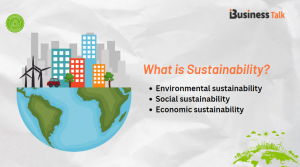
How Can Features of Blockchain Support Sustainability Efforts?
Introduction
As we become more aware of the issues our planet is facing, it’s clear that we need to find new ways to support sustainability efforts. One way to do this is by utilizing blockchain technology and its various features.
In this blog post, we will explore how blockchain can support sustainability efforts in a number of ways. From energy trading platforms to carbon markets, there are a variety of ways that this new technology can be used to make a positive impact on the environment.
What is Sustainability?

The United Nations Brundtland Commission defines sustainability as meeting the needs of the present generation without compromising the ability of future generations to meet their own needs.
In other words, sustainability is about meeting our current needs without damaging the planet or depleting its resources. It is about finding ways to live sustainably on Earth.
There are many different ways to think about sustainability. Often, it is framed in terms of three key pillars: environmental sustainability, social sustainability, and economic sustainability.
Environmental sustainability
Environmental sustainability involves protecting the natural environment and ensuring that it can continue to provide the resources and services we need in the future. This includes reducing our impacts on the environment, such as by reducing greenhouse gas emissions and pollution and protecting ecosystems, such as forests and coral reefs.
Social sustainability
Social sustainability involves creating a just and equitable society where everyone can reach their full potential. This includes ensuring access to basic rights and services, such as education, health care, and housing, as well as addressing social issues like poverty, inequality, and discrimination.
Economic sustainability
Economic sustainability involves creating a prosperous economy that can provide for the needs of current and future generations. This includes creating jobs, promoting investment and trade, and sustainably managing natural resources.
Importance of Sustainability
As the world becomes increasingly digitized, it is important to consider the sustainability of our digital systems. One way to ensure the sustainability of digital systems is to use blockchain technology.
Blockchain is a distributed database that allows secure, transparent, and tamper-proof transactions. This makes it well-suited for supply chain management, carbon trading, and energy trading applications.
Blockchain can help make digital systems more sustainable in several ways. For example, using blockchain technology to track emissions can create a more efficient and effective carbon trading market.
We can create a more efficient and effective energy market by using blockchain to track energy usage. And by using blockchain to manage supply chains, we can create a more efficient and sustainable system of production and consumption.
In short, learning blockchain has the potential to make digital systems more efficient, transparent, and secure. In doing so, blockchain can help us build a more sustainable future.
There are many reasons why sustainability is important,
Firstly, sustainability is important for the environment. The planet is facing some serious environmental challenges, such as climate change, biodiversity loss, and pollution. If we want to protect the environment, we need to find ways to live sustainably.
Secondly, sustainability is important for social justice. Inequalities are rising around the world, and too many people are being left behind. We must find ways to create a more just and equitable society where everyone can reach their full potential.
Thirdly, sustainability is important for the economy. The global economy is facing serious challenges, such as rising debt levels, inequality, and unemployment. We need to find ways to create a more prosperous economy that can provide for the needs of current and future generations.
Finally, sustainability is important for our future. We need to find ways to meet the needs of the present generation without damaging the planet or depleting its resources. This will require a major shift in how we live and do small business. But it is essential if we want to build a sustainable future for all.
What is the Biggest Challenge in Sustainability?
The biggest challenge in sustainability is implementing and enforcing regulations that limit greenhouse gas emissions. The problem is that most countries have not been willing to commit to these regulations, largely because they are seen as costly and lecture-restrictive. However, blockchain technology has the potential to change this by providing a decentralized way to track and enforce emissions trading.
In a nutshell, blockchain registries could be used to monitor and record all carbon-producing activity. This would create transparency and allow for the creation of a marketplace for carbon credits. With the right incentives in place, this could finally give us the push we need to get serious about limiting our impact on the planet.
What are the features of Blockchain that support sustainability?

The features of Blockchain that support sustainability are its distributed ledger, its consensus mechanisms, and its tokenization.
The distributed ledger is a key feature of Blockchain that supports sustainability. The ledger allows for transparent and secure record-keeping of transactions. This can help track the flow of resources and ensure they are being used efficiently.
The consensus mechanisms in Blockchain also support sustainability. These mechanisms allow for decentralized decision-making and ensure that the network is resistant to tampering. This can help to prevent corruption and ensure that sustainable practices are followed.
Tokenization is another key feature of Blockchain that supports sustainability. Tokenization can be used to incentivize sustainable behaviour by rewarding users for taking actions that contribute to environmental protection.
For example, a company could create a token that is awarded to users who recycle their products. This would create a financial incentive for users to recycle, which would ultimately lead to reduced waste and a more sustainable environment.
In conclusion, the features of Blockchain that support sustainability are its distributed ledger, its consensus mechanisms, and its tokenization. These features can help to track resources, prevent corruption, and incentivize sustainable behaviour.
How Can Features of Blockchain Support Sustainability Efforts?

Blockchain technology can help sustainability efforts in a few ways.
First, it can help to create trust between parties who may not have had any previous interactions. This is because blockchain transactions are verified and recorded on a public ledger, which can help to build confidence between buyers and sellers or between companies and their customers.
Additionally, blockchain can help reduce fraudulent activity, as it is very difficult to alter transaction data once it has been recorded. This could potentially reduce other fraud-related business plan costs, such as insurance premiums.
Finally, blockchain technology can help create transparency in supply chains, leading to more efficient use of resources and better management of environmental impacts.
In conclusion, blockchain technology has the potential to support sustainability efforts in a number of ways. By creating trust between parties, reducing fraudulent activity, and increasing transparency in supply chains, blockchain can help us build a more sustainable future.
Conclusion
The features of blockchain technology can support sustainability efforts in several ways. By providing a decentralized platform for tracking carbon emissions, for example, blockchain could help us to monitor better and reduce our environmental impact.
Additionally, the use of smart contracts could automate many sustainable initiatives, such as green energy trading, and make them more efficient and effective. We must continue exploring how best to utilize this powerful tool to create a more sustainable future for all.





